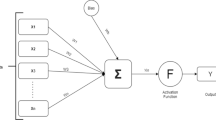Abstract
A useful patient admission prediction model that helps the emergency department of a hospital admit patients efficiently is of great importance. It not only improves the care quality provided by the emergency department but also reduces waiting time of patients. This paper proposes an automatic prediction method for patient admission based on a fuzzy min–max neural network (FMM) with rules extraction. The FMM neural network forms a set of hyperboxes by learning through data samples, and the learned knowledge is used for prediction. In addition to providing predictions, decision rules are extracted from the FMM hyperboxes to provide an explanation for each prediction. In order to simplify the structure of FMM and the decision rules, an optimization method that simultaneously maximizes prediction accuracy and minimizes the number of FMM hyperboxes is proposed. Specifically, a genetic algorithm is formulated to find the optimal configuration of the decision rules. The experimental results using a large data set consisting of 450740 real patient records reveal that the proposed method achieves comparable or even better prediction accuracy than state-of-the-art classifiers with the additional ability to extract a set of explanatory rules to justify its predictions.







Similar content being viewed by others
Notes
Since the number of hyperbox is an integral number, the nearest integral value is reported.
The number of the decision rules is not the same as the number of hyperboxes reported in Table 1 because the number of hyperboxes is the mean of multiple implementations.
We varied the parameters of these four classifiers and found that the accuracies fluctuated slightly.
References
Boyle J, Lind J, Jessup M, Wallis M, Crilly J, Miller P, Green D, Fitzgerald G (2012) Predicting emergency department admissions. Emerg Med J 29:358–365
Jessup M, Wallis M, Boyle J, Crilly J, Lind J, Green D, Miller P, FitzGerald G (2010) Implementing an emergency department patient admission predictive tool: insights from practice. J Health Organ Manag 24:306–318
Sun Y, Heng BH, Tay SY, Seo E (2011) Predicting hospital admissions at emergency department triage using routine administrative data. Acad Emerg Med 18:844–850
Peck JS, Benneyan JC, Nightingale DJ, Gaehde DA (2012) Predicting emergency department inpatient admissions to improve same-day patient flow. Acad Emerg Med 19:1045–1054
Leegon J, Jones I, Lanaghan K, Aronsky D (2005) Predicting hospital admission for emergency department patients using a bayesian network. In AMIA Annu Symp Proc, p 1022
Haykin S (1998) Neural networks: a comprehensive foundation, 2nd edn. Prentice Hall PTR, Upper Saddle River
Freund Y, Schapire RE (1997) A decision-theoretic generalization of on-line learning and an application to boosting. J Comput Syst Sci 55(1):119–139
Bishop CM (2006) Pattern recognition and machine learning. Springer-Verlag New York Inc, Secaucus
Breiman L (2001) Random forests. Mach Learn 45(1): 5–32. ISSN 0885–6125.
Breiman L (1984) Classification and regression trees. The Wadsworth and Brooks-Cole statistics-probability series. Chapman & Hall, London
Simpson PK (1992) Fuzzy min-max neural networks-part 1: classification. IEEE Trans Neural Netw 3(5):776–786
Simpson PK (1993) Fuzzy min-max neural networks—part 2: clustering. IEEE Trans Fuzzy Syst 1(1):32–45
Quteishat A, Lim CP (2008) Application of the fuzzy min-max neural networks to medical diagnosis. In Ignac Lovrek, RobertJ. Howlett, and LakhmiC. Jain, editors, Knowledge-based intelligent information and engineering systems, volume 5179 of Lecture Notes in Computer Science. Springer, Berlin, pp 548–555
Nandedkar AV, Biswas PK (2009) A granular reflex fuzzy min–max neural network for classification. IEEE Trans Neural Netw 20(7):1117–1134. doi:10.1109/TNN.2009.2016419
Seera M, Lim CP, Ishak D, Singh H (2012) Fault detection and diagnosis of induction motors using motor current signature analysis and a hybrid FMM–CART model. IEEE Trans Neural Netw Learn Syst 23(1):97–108
Seera M, Lim CP (2013) Online motor fault detection and diagnosis using a hybrid fmm-cart model. IEEE Trans Neural Netw Learn Syst 99:1–7. doi:10.1109/TNNLS.2013.2280280
Seera M, Lim CP, Ishak D, Singh H (2013) Offline and online fault detection and diagnosis of induction motors using a hybrid soft computing model. Appl Soft Comput 13 (12): 4493–4507. ISSN 1568–4946. doi:10.1016/j.asoc.2013.08.002
Zhang H, Liu J, Ma D, Wang Z (2011) Data-core-based fuzzy min–max neural network for pattern classification. IEEE Trans Neural Netw 22(12):2339–2352. doi:10.1109/TNN.2011.2175748
Davtalab R, Dezfoulian MH, Mansoorizadeh M (2014) Multi-level fuzzy min-max neural network classifier. IEEE Trans Neural Netw Learn Syst 25 (3): 470–482. ISSN 2162–237X. doi:10.1109/TNNLS.2013.2275937
Benitez JM, Castro JL, Requena I (1997) Are artificial neural networks black boxes? IEEE Trans Neural Netw 8(5):1156–1164
Taha IA, Ghosh J (1999) Symbolic interpretation of artificial neural networks. IEEE Trans Knowl Data Eng 11(3):448–463
Carpenter GA, Tan A (1995) Rule extraction: from neural architecture to symbolic representation. Connect Sci 7:3–27
Setiono R, Leow WK, Zurada JM (2002) Extraction of rules from artificial neural networks for nonlinear regression. IEEE Trans Neural Netw 13(3):564–577
Ishibuchi H, Nozaki K, Yamamoto N, Tanaka H (1994) Construction of fuzzy classification systems with rectangular fuzzy rules using genetic algorithms. Fuzzy Sets Syst 65(2–3): 237–253. ISSN 0165–0114
Ishibuchi H, Nii M, Murata T (1997a) Linguistic rule extraction from neural networks and genetic-algorithm-based rule selection. In: International conference on neural networks vol 4, pp 2390–2395
Ishibuchi H, Murata T, Turksen IBIB (1997b) Single-objective and two-objective genetic algorithms for selecting linguistic rules for pattern classification problems. Fuzzy Sets Syst 89(2):135–150
Quteishat A, Lim CP (2008b) A modified fuzzy min-max neural network with rule extraction and its application to fault detection and classification. Appl Soft Comput 8(2):985–995
Quteishat A, Lim CP, Tan KS (2010) A modified fuzzy min-max neural network with a genetic-algorithm-based rule extractor for pattern classification. IEEE Trans Syst Man Cybern Part A Syst Hum 40(3):641–650
Mitchell M (1998) An introduction to genetic algorithms. MIT Press, Cambridge
Zoubir AM, Boashash B (1998) The bootstrap and its application in signal processing. IEEE Signal Process Mag 15(1):56–76
Murphy PM, Aha DW (1995) UCI Repository of Machine Learning Databases, (Machine-Readable Data Repository). Dept. Inf. Comput. Sci., Univ. California, Irvine, CA
Acknowledgments
The authors would like to thank Ballarat Health Services, Australia, and Victorian Department of Health, Australia, for giving us access to the patient admission dataset.
Author information
Authors and Affiliations
Corresponding author
Rights and permissions
About this article
Cite this article
Wang, J., Lim, C.P., Creighton, D. et al. Patient admission prediction using a pruned fuzzy min–max neural network with rule extraction. Neural Comput & Applic 26, 277–289 (2015). https://doi.org/10.1007/s00521-014-1631-z
Received:
Accepted:
Published:
Issue Date:
DOI: https://doi.org/10.1007/s00521-014-1631-z




